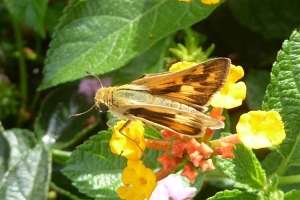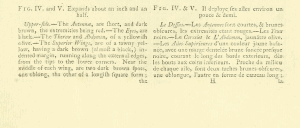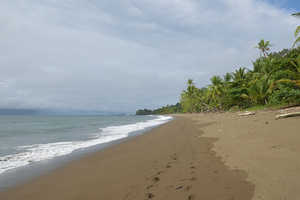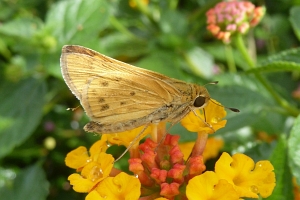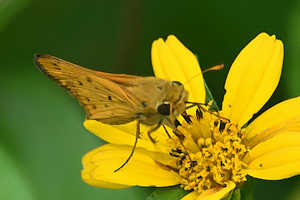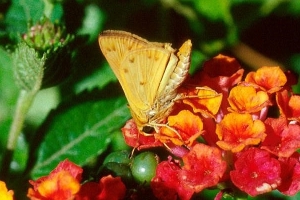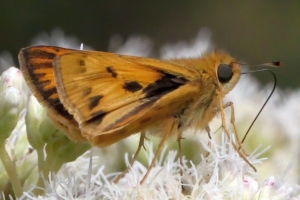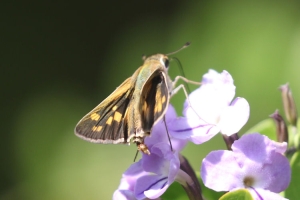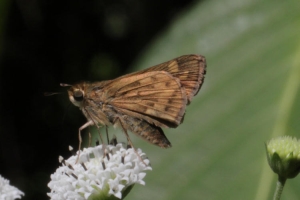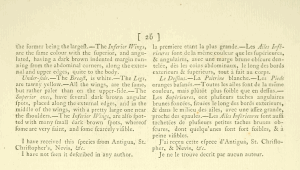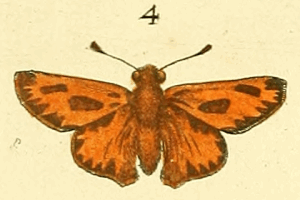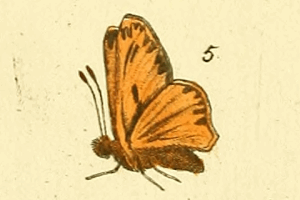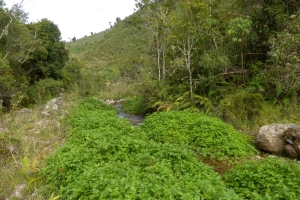

 +48Kontinente:EUNAMAKISAOC
+48Kontinente:EUNAMAKISAOC1. Lebendfotos
1.1. Falter
2. Diagnose
2.1. Erstbeschreibung
3. Biologie
3.1. Habitat
3.2. Nahrung der Raupe
- [Poaceae:] Cynodon sp. (Hundszahn)
- [Poaceae:] Agrostis sp. (Straußgras)
Die Raupe frisst Gräser. Doch welche das sind, ist noch immer unzureichend geklärt. Jedenfalls wird die Raupe kaum gefunden - was man mit vermutlicher Nachtaktivität begründet. Die Angaben zu den einzelnen Grasarten entstammen also zum einen beobachteten Schäden in Zierrasen, die dieser Raupe zugeordnet werden und umfangreichen Zuchtbeobachtungen.
Bei Tashiro & Mitchell (1985) kommt diese Diskrepanz gut zum Ausdruck: "The larvae feed on all the common lawn grasses with possible preference for bermudagrasses Cynodon spp. and bentgrasses Agrostis spp. (Okumura 1959). Early symptoms of infestation are characterized by isolated round spots with lack of leaf blades (Bohart 1947). Larvae are seldom seen, even when abundant, since they remain concealed in lightly woven silken tubes in the thatch area. During two different 6-month periods (1975 and 1982) I did not see a single larva on the turfgrass although a few were observed under plywood placed on turf overnight as a sampling technique (Mitchell and Murdoch 1974) and a few were forced to the turfgrass surface with liquid irritants (Tashiro, Murdoch and Mitchell, in press)."
Deputy & Hara (2000) ordnen die Schäden an Rasen in Hawaii ein: "he most common insect pests of turfgrasses in Hawaii are “lawn caterpillars,” the larvae of lepidopterous insects (moths and butterflies). Major pests in this group are three moths and one butterfly. The moths are the grass webworm (Herpetogramma licarsisalis Walker), the lawn armyworm (Spodoptera mauritia acronyctoides Guenee), and several species of cutworm including the black cutworm (Agrotis ipsilon Hufnagel). The butterfly is the fiery skipper (Hylephila phyleus Drury). All of Hawaii’s turfgrasses are susceptible to attack by these four pests, although some of these insects prefer a particular type of turf. The grass webworm does the most damage and is therefore the most important turf pest in Hawaii, and the lawn armyworm also causes extensive injury. Serious outbreaks of damage by the black cutworm and fiery skipper occur less frequently." Zu H. phyleus heißt es: "The fiery skipper caterpillar prefers bermudagrasses. The larvae develop more slowly on zoysiagrasses and centipedegrass and are seldom seen on St. Augustinegrass. Fiery skipper eggs are laid singly on the undersurface of grass leaves and stems. They hatch 2–3 days after being laid. The fiery skipper caterpillar has a prominent head due to its narrow neck. The fiery skipper lays its eggs singly on a blade of grass. The larva has distinctive, reddish markings on the front of its oversized, black head. It has a narrow neck, followed by a dark thoracic shield and a greenish-pink body with a granulated texture. The caterpillars spin silk shelters in the thatch and are not readily seen unless flushed out by a pyrethrin or detergent test. The average length of time to complete the larval stage is approximately 16 days. Fiery skipper damage in turf is a 1–2-inch round spot from which all the grass has been eaten by a single larva. If there is a large population, these spots will combine into larger dead patches. Damage usually appears on turf located near flowerbeds, where the adult skippers feed. The mature fiery skipper caterpillar burrows into the soil to form a pupa that is light yellow but otherwise similar in appearance to the pupa of the grass webworm or the black cutworm. The adult butterfly emerges in 7–10 days."
Die Liste der tatsächlich im Freiland genutzten Süßgräsern dürfte lang sein.
(Autor: Erwin Rennwald)
4. Weitere Informationen
4.1. Andere Kombinationen
- Papilio phyleus Drury, 1773 [Originalkombination]
4.2. Synonyme
- Hylephila phareus (Panzer, 1785) [Synonym nach funet.fi]
- Papilio druryi Megerle, [1803] [Synonym nach funet.fi]
- Hesperia carin Hübner, 1823 [Synonym nach funet.fi]
- Pamphila bucephalus Stephens, 1828 [Synonym nach funet.fi]
- Pamphila hala Butler, 1870 [Synonym nach funet.fi]
4.3. Unterarten
- Hylephila phyleus anca Evans, 1955 [Unterart nach funet.fi]
- Hylephila phyleus andina (Staudinger, 1894) [Unterart nach funet.fi]
- Hylephila phyleus basistrigata (Eaton, 1932) [Unterart nach funet.fi]
- Hylephila phyleus monticola Hayward, 1939 [Unterart nach funet.fi]
- Hylephila phyleus taxus Evans, 1955 [Unterart nach funet.fi]
4.4. Faunistik
Agassiz et al. (2013: 112) führen die Art bei den "adventive species" und schreiben zu England: "Two, probably a chance importation, Devon, 1820. North American."
Nach [Global Biodiversity Information Facility] kommt die Art in USA, Mexiko, Argentinien, Kanada, Brasilien, Kuba, Kolumbien, Peru, Uruguay, Martinique, Costa Rica, Guadeloupe, Jamaika, Ecuador, Bonaire, Sint Eustatius und Saba, Dominikanische Republik, Puerto Rico, Panama, Chile, Belize, Honduras, Suriname, Guatemala, Haiti, Paraguay, Saint-Barthélemy, Bahamas, Französisch-Guayana, Curacao, Guam, St. Kitts und Nevis, Nicaragua, Trinidad und Tobago, Indonesien?, Sint Maarten, Britische Jungferninseln, Amerikanische Jungferninseln, Kaimaninseln, St. Martin, Antigua und Barbuda, Aruba, Bolivien, St. Lucia, Montserrat, Venezuela, Anguilla, Barbados und Grenada vor.
Locus typicus gemäß Erstbeschreibung: Antigua, St. Christopher & Nevis. Die Art ist in den USA nur im Süden bodenständig, wandert aber anscheinend regelmäßig nordwärts. Selbstverständlich gibt es auch in Kanada keine erfolgreiche Reproduktion und keine dauerhaften Populationen. Clements (2012) erklärt: "In North America, this species is resident only in the southern United States, but is known to wander north, with observations recorded in the United States as far afield as California, Connecticut, Michigan, Massachusetts, Nebraska, and Wisconsin (Klots 1951; Okumura 1959; Tashiro and Mitchell 1985; Maritimes Butterfly Atlas 2011; Wisconsin Butterflies 2012). Although Hylephila phyleus is known to regularly cross the Canadian border into southwestern Ontario (Layberry et al. 1998). However, in the Maritimes, this species is previously known only from a single specimen in the Canadian National Collection, obtained at Charlottetown, Prince Edward Island, 29 July 1947. Layberry et al. (1998) accept this record because ”migrants flying northwards towards the northeastern states quite likely follow the coast to some extent, and could have been carried into the Maritimes by strong south winds.” Moreover, although Hylephila phyleus has been observed in copula in Canada, it is thought that their larvae are incapable of withstanding the cold winters, making the possibility of an established Canadian population highly unlikely (Layberry et al. 1998). Although Hylephila phyleus has been divided into three subspecies in its resident geographic range, Layberry et al. (1998) suggested that only the nominate subspecies (Hylephila phyleus phyleus) enters Canada. On 26 August 2012, I photographed and collected a single female Fiery Skipper (Figure 1a,b) at the northeastern end of Lily Lake, Rockwood Park, Saint John, New Brunswick (45°17’28.63”N, 66°03’17.02”W). The skipper was flying in an area of trailside grass and alders. The park, designed and established in the late 19th century, is one of Canada’s largest urban parks, spanning 890 hectares of mixed forest land. Various habitats are present throughout the park, including trailside grassy areas, well developed secondary mixed forest, and freshwater ponds and lakes. The specimen has been spread, pinned and deposited in the insect collection of the New Brunswick Museum as NBM 33431. Hylephila phyleus can be considered a rare migrant in the Maritime Provinces. Observations of this species may increase in the region in the future if the unseasonably warm and dry weather patterns of 2012 continue."
(Autor: Erwin Rennwald & Michel Kettner)
4.5. Literatur
- Agassiz, D.J.L., Beavan, S.D. & R.J. Heckford (2013): Checklist of the Lepidoptera of the British Isles. - Royal Entomological Society. 206pp.
- Clements, J.C. (2012): First record of the Fiery Skipper, Hylephila phyleus Drury (Lepidoptera: Hesperiidae) from New Brunswick, Canada. — Journal of the Acadian Entomological Society, 8: 59-60. [zum PDF-Download auf researchgate.net]
- Deputy, J. & A. Hara (2000): Destructive Turf Caterpillars in Hawaii. — College of Tropical Agriculture and Human Resources. Insect Pests, 5: 8–9. [zum PDF-Download auf academia.edu]
- Erstbeschreibung: Drury, D. (1773): Illustrations of Natural History. Wherein are exhibited Upwards of Two Hundred and Twenty Figures of Exotic Insects, According to their different Genera; Very few of which have hitherto been figured by any Author, Being engraved and coloured from Nature, with the greatest Accuracy, and under the Author's own Inspection, On Fifty Copper-Plates. With a particular Description of each Insect: Interspersed with Remarks and Reflections of the Nature and Properties of many of them. Vol. II: i-vii, 1-90, pl. I-L, Index to the First Volume, Errata and Addenda to the First Volume [not paginated], Index to the Second Volume, Errata and Addenda to the Second Volume [not paginated]. London.
- Tashiro, H. & W.C. Mitchell (1985): Biology of the fiery skipper, Hylephila phyleus (Lepidoptera: Hesperiidae), a turfgrass pest in Hawaii. — Proceedings of the Hawaiian Entomological Society, 25: 131-138. [PDF auf core.ac.uk]

















































